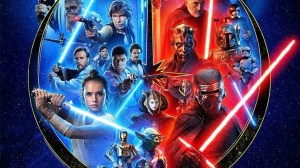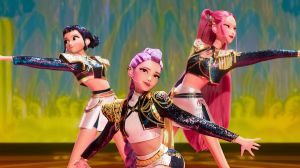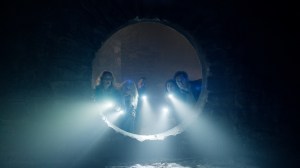Heroes Con opened at 11AM on Sunday, the final day of the convention, and things quickly began, as a panel focused solely on DC icon Wonder Woman. In attendance were current artist on Wonder Woman Cliff Chiang, colorist for the series Matt Wilson and Ben Caldwell, who worked on the character during DC’s popular Wednesday Comics feature a few years ago. They were ready and eager to discuss the aspects and challenges of working on one of the most well known and longest lasting DC franchises, and the conversation took some surprising turns in discussing the character, both then and now.The first question was a general one, but it quickly came into focus in regards to Wonder Woman: What is it like wearing both hats on a character as artist and writer? Caldwell responded, “Everything I do as an artist and writer I tend to rush into it. Something that sounds great on a page doesn’t always translate onto the visual. Doing both means I can mess around with the story and the layout and have it unfold from there.” Chiang talked about his current work on Wonder Woman with series writer Brian Azzarello, “It’s important to be able to change things as they go along. I’ve been working with Azzarello for a few years now and so I know him. Wonder Woman has been great because we talk a lot. It’s good to plan things with him and when I get a script there’s room to interpret and add side bits to it. Because he’s a writer he’s usually more focused on the dialogue bringing out the character, but my job as the artist is to bring those things to life. One of the things the other day, I was drawing a scene where the Amazons are fighting about Wonder Woman and how there’s a split between them, and I cut to a scene to some crabs fighting on the beach. It sort of punctuated the mood of that scene I thought, and Azareello is fine with those types of touches because they enhance the story.”Chiang then went on to expound on just how Azzarello approached this new incarnation of Wonder Woman. “It all started with Jim’s [Lee] design with Wonder Woman. We had talked about doing this for awhile before the relaunch. Jim redesigned her, and we thought we may just as well redesign everything. The tone of the book and this idea of trying to do something mythological yet contemporary and to revamp the gods so they’re more urban fantasy was our vision. Once we had that, we tried to give the characters something visually that would really be striking, and the design process was involved and detailed. We started with Hermes, and originally we went with a western look. He initially had this long, duster coat and what we ended up with was a sort of World War I go-go boy with chicken feet, so that’s a different take. We wanted a very fresh feel for this book.” Adding to his discussion on the designing of the gods, Chiang said that Poseidon, Hades, Lennox, and Persephone, all were designed by Tony Akins. “The main driving force for designing was to not make these characters seem old,” said Chiang, “the togas and columns are gone. We wanted to make it unpredictable as to what these gods looked like. You don’t know what you’re going to get with them, and that’s been crucial for the book.”Tone and design were touched on as well in regards to Wonder Woman’s costume and the whole pants/no pants “controversy” that sprung up with it. “I find that whole thing fascinating,” said Chiang, “that this really is a big deal to a lot of people, the look of this character.” The look of the character was of key importance in the development of things as well. “Before we knew Jim was redesigning all the characters,” Chiang said, “we had a sort of gladiator armor look for her before, and there’s such strong iconography with the character, you want the eagle, the gold, the blue, and you have to ask how far can you push it before it becomes unrecognizable. I think it would be fun to introduce a new outfit at some point in the future, but we like the look we have now.”A question from the crowd asked about Wonder Woman’s rogues gallery and the possibility of those characters being introduced any time soon. “We’ve not really discussed reintroducing the classic villains at this time,” said Chiang, “Brian isn’t as big a fan of the superhero stuff, but if there would be a way to introduce those I think we would do it. I know he’s trying to do a sort of noir, The Sopranos type of thing with the book, but I think if a story could work with a character then maybe. Someone like Circe could work obviously, but I don’t know about attempts from characters like Cheetah or Giganta at this time.”While many think of Wonder Woman’s readership to me a mostly female audience, Chiang said that those thoughts aren’t really a concern for himself or Azzarello. “You try to approach any character with as much respect for the character as possible. You’re respecting the story. You wouldn’t do overtly cheesecakey things that you might do in other books, because it doesn’t make sense with this character. That’s not what Wonder Woman’s about. That’s what I find most interesting. People ask me why there are so many sexually charged shots in so many comics, and to me that’s a conscious choice. That’s the artist’s fault there. You’re choosing to make things look they way they do.” Caldwell commented on his use of the character during the run of Wednesday Comics, “I’m usually interested in younger characters and that’s why I emphasized that younger, newer part of her because seeing her figure things out is interesting. I focused on her development as an athletic girl growing up in an exotic, powerful place.” “I don’t think about gender for colors,” said Wilson, “we talked early on about that color popping, and we talked about having a sophistication early on. There’s definitely a certain tone that we’re going for in the book that the colors can communicate, no matter the audience.” Chiang talked about the bottom line was in making this book appeal to a wide audience, gender aside.One question that really generated a lot of discussion amongst the panel was the subject of what exactly made Wonder Woman such a hard sell for people as a book. Caldwell put it bluntly by saying, “Because Wonder Woman at its heart is about the adventures of a fabulous princess who is from a fantasty island. Who you’re trying to sell this to at the bottom line is not the same match as to who is buying Superman and Batman. Her origin also has twice as much weight and complication as other origin stories.” Chiang tagged onto that and talked about the perception problem that some readers who have never read Wonder Woman may have about the character. “People say ‘I’m not going to read a girl book’ and that’s not what it’s about at all. I’ve been talking to a lot of people at this show that are picking up this book now because Brian’s writing it. He has an edge to his work that makes people like his stuff, so they’re reading it now,” Chiang said.He went on to address the tone of the book in that same vein. “One of the things I may regret about what we’re doing is that our tone may be a little hard for a younger audience. I would love to do something like this for a younger audience because of the iconic power she has, and I think young kids need to see that, and to see her succeeding at that.” Caldwell added, “I was pushing a graphic novel/manga to DC, but there were hangups with that because marketing is so set. It’s hard to get a new audience because there are so many predictions with that kind of business model. They know who is going to buy what and in what quantity. Wonder Woman is unique because there is that tension over how to market her with what she is now.” Everyone on the panel agreed that digital publishing would be a way to help increase the visibility of the character and to grow her audience.An interesting and controversial part of Wonder Woman’s history came into discussion somehow as well: the checkered past of Wonder Woman’s “bondage past”. “The old bondage stuff is pretty funny,” said Chiang, “and I didn’t realize that that was a factor for some people. That’s Wonder Woman to them: she gets tied up. I didn’t realize it was such a heavy thing and that there was such an audience for it.” Caldwell commented, “I have a problem with the treatment of the bondage; at no point did people say why it was there. I have an issue with a lot of modern treatments where people take subtexts of things and make it the main text and to me that’s not great. The big question is what are you going to be adding to the story to make it interesting, especially with these mythological creatures hanging around and coming up.” Chiang seconded that feeling, “What’s hard related to Wonder Woman is what she represents. You have to be aware of what the subtext of a character might be saying visually. A lot of her older covers are her in peril or jeopardy and you never see Batman and Superman that way. They’re doing this because she’s a woman and you have her with these phallic representatives in front of her, and you don’t see male heroes that way. It’s not even considered with male characters. You have to try to avoid that and be careful what you are saying. Female heroes don’t have to be rescued. Covers are a main visual for the book. I try to avoid damsel in distress type of things. She’s in charge of situations where there may be peril. You want the images to be empowering. Even if that book is not for a six year old girl, I don’t want to have a problem showing a six year old girl that cover.”The panel wound down with some discussion of possible upcoming storylines. Some in the audience suggested that it would be interesting to see if Wonder Woman would begin interacting with any other regions or religions and their gods anytime soon. Chiang seemed to be interested in the possibility that could be presented with that, noting a particular interest in the Egyptian gods. All in all, a very interesting, rich way to spend an hour!









